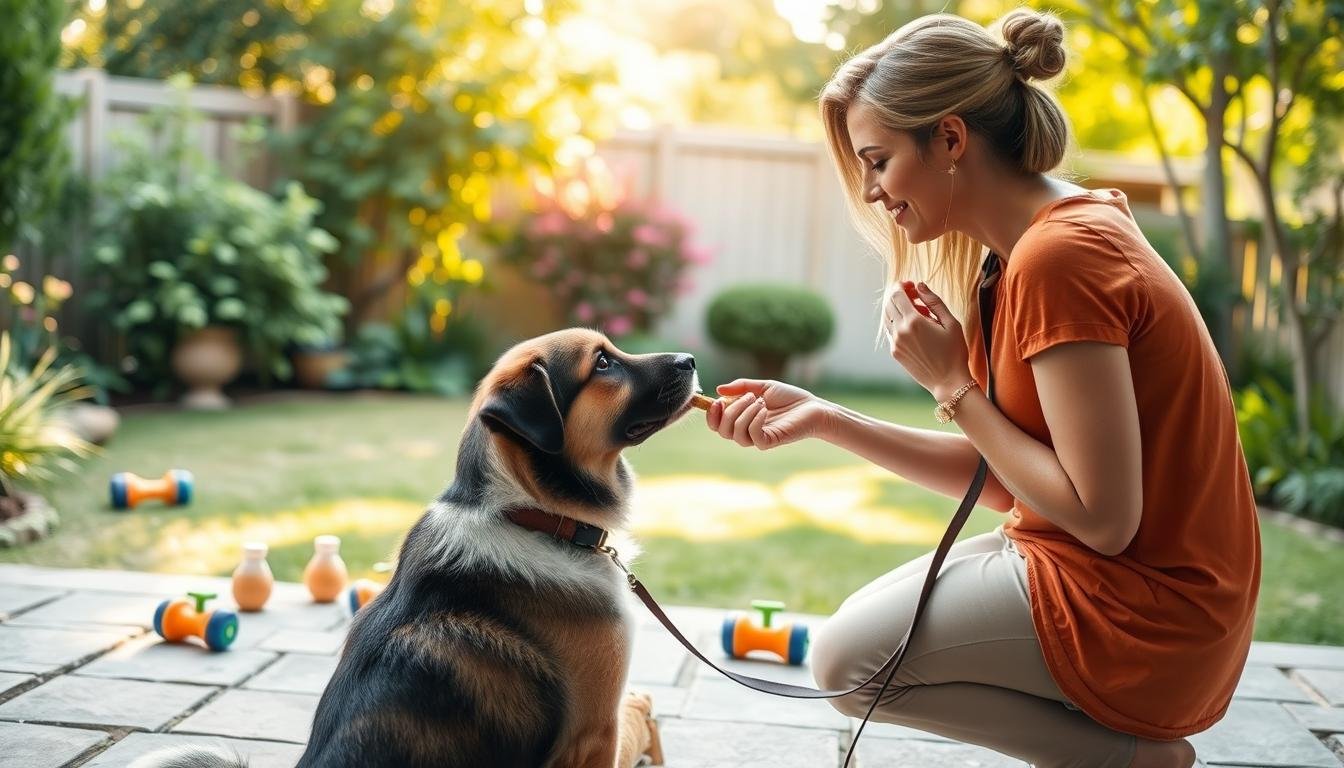Reactive Dog Training: Best Techniques to Calm Your Anxious Dog
Is your dog’s anxiety affecting their behavior? They might react impulsively to certain things. Many pet owners face this challenge, making life stressful for everyone.

Knowing why your dog is anxious and using the right techniques for reactive dog training can help. This article will show you how to spot anxiety signs, understand reactivity, and use training to calm your dog. It will also help you bond with your dog more.
Table of Contents
Understanding Dog Reactivity: Causes and Manifestations
Dog reactivity is when dogs act out in response to certain things. It’s important to know why and how it happens. This behavior can be due to fear, lack of socialization, or past traumas.
Common Triggers for Reactive Behavior
Finding out what makes dogs react is key. Things like other dogs, strangers, loud sounds, or certain places can trigger it. Knowing these triggers helps in teaching dogs to handle their reactions better.
The Difference Between Reactivity and Aggression
It’s crucial to tell the difference between reactivity and aggression. Reactivity comes from fear or anxiety, while aggression is a choice to harm. Knowing this helps in choosing the right ways to change a dog’s behavior.
Understanding why your dog reacts and what triggers it is the first step. Then, you can start working on ways to help them feel better and behave.
Recognizing Signs of Anxiety in Your Reactive Dog
Knowing the signs of anxiety in your dog is key to managing reactivity. Dogs show physical and behavioral signs when they’re anxious. Learning to spot these signs is crucial.
Physical Indicators of Stress
Your dog’s body language can show their stress levels. Look for panting, yawning, and licking as signs of anxiety. Also, watch for tail tucking, lowered ears, and avoiding eye contact. These postures mean they’re uncomfortable.
Behavioral Patterns to Watch For
Reactive dogs have unique behaviors when they’re anxious. Body Language Cues include stiffening, freezing, or leaning away. This is especially true in stressful situations.
Body Language Cues
Notice how your dog positions themselves in stressful situations. Also, look for avoidance behaviors like hiding or running away.
Vocal Signals
Vocal signs like barking, growling, or whining are clear signs of anxiety. These sounds tell you your dog is feeling stressed.
Effective Reactive Dog Training Techniques
Reactive dog training is more than just fixing behavior. It’s about understanding and empathy. To train a reactive dog well, you must tackle the reasons behind their reactivity.
Desensitization Methods
Desensitization means slowly introducing your dog to the thing that makes them react. Start from a safe distance or with a low intensity. The aim is to make your dog less reactive over time.
Counter-Conditioning Strategies
Counter-conditioning links the trigger with something good, like treats or praise. This method can work very well if done right.
The Look-at-That Game
The “Look-at-That” game is a fun way to teach your dog to focus on you when they see a trigger. You reward them for looking at you, not the trigger.
- Start by identifying your dog’s triggers.
- Gradually introduce the trigger at a safe distance or intensity.
- Reward your dog for calm behavior.
Common Mistakes to Avoid
A big mistake is moving too fast, which can stress your dog out. Be patient and adjust your training pace based on your dog’s comfort. As Karen Pryor, a famous animal trainer, said, “The most important thing in training is to be calm, clear, and consistent.”
“The most important thing in training is to be calm, clear, and consistent.”
By using these techniques and avoiding common mistakes, you can help your reactive dog feel more confident and calm around triggers.
Positive Reinforcement for Reactive Dogs
Reactive dogs do well with positive reinforcement. This method rewards good behavior. It helps them feel calm and confident. It’s about what you want them to do, not what not to do.
Choosing the Right Rewards
Choosing the right rewards is key. For many dogs,high-value treatswork best. Think cooked chicken, cheese, or their favorite snack. Pick something they can’t resist.
Timing and Consistency in Reward Delivery
When to give rewards is important. Give themimmediatelyafter the good behavior. It’s also crucial to be consistent. Make sure everyone uses the same rewards and commands.
Clicker Training Applications
Clicker training uses a sound to mark good behavior. It’s great for reactive dogs. It gives a clear signal right away.

- Reduces anxiety and stress
- Boosts confidence
- Improves behavior in stressful situations
Using positive reinforcement can make your reactive dog calmer and more confident. It’s a powerful training tool.
Creating a Safe Training Environment
To train a reactive dog well, you need a safe space. This space should have few triggers and lots of learning chances. A good training area lowers your dog’s stress, making them ready to learn.
Setting Up Your Home for Success
First, check your home for things that might upset your dog. Block access to windows or use opaque curtains to keep them calm. Pick a quiet spot for training where your dog can focus without getting distracted.
Managing Outdoor Environments
Outside, pick places with few distractions. Stay away from busy areas or places that might upset your dog. Keep your dog on a leash and be ready to redirect their attention if they react.
Using Equipment: Harnesses, Leashes, and Muzzles
The right gear is key for your dog’s safety and your control. Use a comfortable harness instead of a collar to avoid pain and injury. Sometimes, a muzzle is needed for safety, especially in places with triggers.
By managing your dog’s space and using the right gear, you can make a safe training area. This area supports your dog’s learning and happiness.
Daily Management Strategies for Reactive Dogs
To train a reactive dog, daily management is key. It helps keep them calm and reduces their reactivity. This includes a routine, enough exercise, mental play, and handling triggers.
Establishing Routine and Structure
A daily routine lowers your dog’s stress. It makes them feel secure. Regular times for meals, walks, training, and sleep are important.
Consistency is key to your dog’s calmness.
Exercise and Mental Stimulation Needs
Reactive dogs need regular physical exercise to release energy. Mental games like puzzle toys or scent work also help. They tire your dog’s mind, making them less reactive.
Handling Unavoidable Trigger Situations
Even with planning, triggers can still happen. It’s important to know how to calm your dog fast. Also, know when to remove them from the trigger.
| Daily Management Aspect | Strategy | Benefit |
|---|---|---|
| Routine and Structure | Consistent daily schedule | Reduces stress and anxiety |
| Exercise and Mental Stimulation | Physical exercise and mental activities | Reduces energy and reactivity |
| Handling Triggers | Quick calming techniques and removal from trigger | Minimizes reactive episodes |

When to Seek Professional Help
Knowing when to get help for a reactive dog is crucial. Some owners can handle their dog’s reactivity alone. But, others might need help from a professional trainer or behaviorist.
Finding a Qualified Trainer or Behaviorist
To find a good professional, look for those with experience in helping reactive dogs. Check if they have certifications from places like the Certification Council for Professional Dog Trainers (CCPDT) or the International Association of Animal Behavior Consultants (IAABC).
What to Expect from Professional Intervention
A professional will first assess your dog’s behavior. Then, they’ll create a training plan just for your dog. They’ll teach you desensitization and counter-conditioning techniques that fit your dog’s needs.
“Working with a professional trainer or behaviorist can significantly improve your dog’s reactivity and overall well-being.”
Medication Options and When They’re Appropriate
Sometimes, a vet might suggest medication for your dog’s reactivity. This is usually when the reactivity is very severe or other methods haven’t worked.
| Professional Help Options | Description | Benefits |
|---|---|---|
| Certified Trainers | Experienced in behavior modification | Customized training plans |
| Behaviorists | Specialized in understanding dog behavior | In-depth behavioral assessments |
| Veterinarians | Medical professionals for dogs | Medication recommendations when necessary |
Conclusion: Patience and Persistence in Your Reactive Dog Journey
Managing a reactive dog is a journey that needs patience and persistence. It’s about understanding why your dog reacts, knowing when they’re anxious, and using the right training methods.
Using techniques like desensitization, counter-conditioning, and positive reinforcement can help. These methods make your dog more confident and calm around triggers. Keep working on training and ask for help when you need it.
With time and the right approach, your reactive dog can overcome their fears. This will also strengthen your bond. Stay patient and persistent to overcome the challenges of reactive dog training and enjoy a better life with your dog.
FAQ
What is dog reactivity, and how is it different from aggression?
Dog reactivity is when a dog has a strong reaction to something like people, other dogs, or noises. It’s different from aggression because the dog’s intent is not to harm. Instead, they might be scared, anxious, or excited.
How can I identify signs of anxiety in my reactive dog?
Look for physical signs like panting, yawning, and pacing. Also, watch for behaviors like avoiding things, whining, or barking too much. Spotting these signs helps you manage your dog’s reactivity.
What is desensitization, and how can it help my reactive dog?
Desensitization is a training method. It starts by slowly exposing your dog to the thing that makes them react. This is done from a safe distance or at a low level. It aims to reduce your dog’s stress or anxiety over time.
How does positive reinforcement work in reactive dog training?
Positive reinforcement rewards your dog for calm behavior or following commands near triggers. This teaches your dog to stay calm and react less intensely.
Can I train my reactive dog on my own, or do I need professional help?
Some owners can train their reactive dogs alone with the right methods. But, if your dog’s reactivity is severe or doesn’t improve, professional help is a good idea. A trained expert can offer tailored advice and support.
What are some daily management strategies for living with a reactive dog?
Daily strategies include setting a routine, exercising and mentally stimulating your dog, and avoiding triggers. A structured environment helps reduce your dog’s stress and reactivity.
How can I create a safe training environment for my reactive dog?
Make your home and outdoor spaces safe by minimizing triggers and ensuring your dog’s safety. Use tools like harnesses, leashes, and muzzles. Choose quiet, distraction-free areas for training.
Are there any specific techniques for handling unavoidable trigger situations?
When faced with triggers, stay calm and follow a plan. The “Look-at-That” game can help your dog focus on you and stay calm, even in tough situations.

